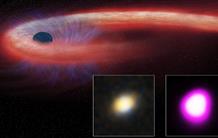At the center of a small galaxy located about 1.8 billion light-years from Earth, a giant black hole swallowed a star for about a decade, which is exceptionally longer than any observed episode of this kind. This discovery was made by an international collaboration involving an astrophysicist from IRFU, thanks to a trio of orbiting X-ray telescopes.
When a star comes near a black hole, the tidal forces caused by the intense gravity of the black hole can destroy the star. Some debris are ejected at high speed from the black hole, while the rest falls on it inexorably, heating up to millions of degrees and emitting characteristic X-rays.
Since 2005, an X-ray source associated with a Tidal Disruption Event has been detected in X-rays by Chandra (NASA), Swift (NASA) and XMM-Newton (ESA) observations. The quickly increasing brightness and long bright phase raises the following question for the scientists: Did the black hole devour the most massive star ever observed during such an event, or did it completely swallow a smaller star?
This study should better explain how black holes could reach nearly a billion solar masses when the universe was only one billion years old.
Contacts : Pierre-Alain DUC
Publication :
"A likely decade-long sustained tidal disruption event"
Dacheng Lin et al. (2017), Nature Astronomy (Mars 2017)
 arxiv.org/abs/1702.00792
arxiv.org/abs/1702.00792
• Structure and evolution of the Universe › Evolution of the large structures and galaxies
• Institute of Research into the Fundamental Laws of the Universe • The Astrophysics Division (DAp)

